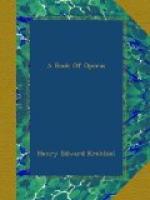The tragedy now begins. Boito changes the order of the scenes which he borrows from Goethe, presenting first the merrymaking of the populace outside the walls of Frankfort-on-the-Main, and then the interview between Faust and Mefistofele, in which, as in the opening scene of Gounod’s opera, the infernal compact is agreed upon. There is some mediaeval pageantry in the first scene,—a cavalcade headed by the Elector, and including dignitaries, pages, falconers, the court fool, and ladies of the court. Students, townspeople, huntsmen, lads, and lasses pursue their pleasures, and up and down, through the motley groups, there wanders a gray friar, whose strange conduct repels some of the people, and whose pious garb attracts others. Faust and Wagner, his pupil, come upon the scene, conversing seriously, and stop to comment on the actions of the friar, who is approaching them, supposedly in narrowing circles. Wagner sees nothing in him except a mendicant friar, but Faust calls attention to the fact that to his eye, flames blaze up from his footprints. This friar is the “poodle” of Goethe’s poem, and Mefistofele in disguise. It is thus that the devil presented himself to Faustus in the old versions of the legend, and as a friar he is a more practicable dramatic figure than he would have been as a dog; but it cannot but provoke a smile from those familiar with Goethe’s poem to hear (as we do in the opera a few moments later) the familiar lines:—
Das also war des Pudels Kern!
Ein fahrender Scolast?
turned into: “This, then, was the kernel of the friar! A cavalier?” The music of the score is characterized by frequent changes from triple to double time, as illustrated in the opening measures:
[Musical excerpt]
The rhythmical energy and propulsiveness thus imparted to the music of the merrymaking is heightened by the dance. Peasants rush upon the scene with shouts of “Juhe!” and make preparations to trip it while singing what, at first, promises to be a waltz-song:—
[Musical excerpt]
The dance, however, is not a waltz, but an obertass—the most popular of the rustic dances of Poland. Why should Boito have made his Rhinelanders dance a step which is characteristically that of the Poles? Sticklers for historical verity could easily convict him of a most unpardonable anachronism, if they were so disposed, by pointing out that even if German peasants were in the habit of dancing the obertass now (which they are not), they could not have done it in the sixteenth century, which is the period of the drama, for the sufficient reason that the Polish dance was not introduced in North Germany till near the middle of the eighteenth century. But we need not inquire too curiously into details like this when it comes to so arbitrary an art-form as the opera. Yet Boito was his own poet, master of the situation so far as all parts of his work were concerned, and might have consulted historical accuracy in a department




